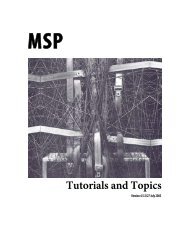MSP; "A Primer on Compression" - Peabody Computer Music
MSP; "A Primer on Compression" - Peabody Computer Music
MSP; "A Primer on Compression" - Peabody Computer Music
You also want an ePaper? Increase the reach of your titles
YUMPU automatically turns print PDFs into web optimized ePapers that Google loves.
Tutorial 5: Multiband Compressi<strong>on</strong>It’s usually the case that the bass, drums, vocals and other instruments are individually compressedbefore they are mixed together. Sometimes this is not possible or desirable. Forinstance, a radio stati<strong>on</strong> or a DJ may wish for a louder and more c<strong>on</strong>sistent sound thanassorted CDs happen to provide. Simple compressi<strong>on</strong> is seldom satisfactory for this situati<strong>on</strong>,because sustained parts will be pumped by the vocals and drums. To prevent this, amultiband compressor treats each secti<strong>on</strong> of the audio spectrum independently; you can havea full bass and c<strong>on</strong>stant rhythm while still letting the voice be heard.The multiband compressor has found creative uses bey<strong>on</strong>d the original intent of spicing upFM radio. If you start with a fairly intense broadband headbanger mix, you can use the deviceto cram every last dB into every octave for that solid wall-of-sound effect. Or, with a bit ofrestraint, you can master a recording to give a comfortable experience <strong>on</strong> a wide range ofplayback systems.Spectral BalancingGood arrangers know how to orchestrate a score to give a balance between bass and treblethat is satisfying and keeps the listener’s attenti<strong>on</strong>. This is called spectral balance. A similareffect can be achieved by compressing bass, midrange, treble, and high frequencies forc<strong>on</strong>sistency and adjusting the levels of each to fit a curve that matches mid and treble, leavesslightly less bass, and somewhat lower top end. This curve comes from analyzing the overallresp<strong>on</strong>se of many successful albums.The 4-band compressor does a good job of solidifying a mix. The patch C5a. MultibandComp 4band shows the omx.4band~ object in acti<strong>on</strong>. This is a really complex gadget, far morethan four compressors lashed together. There is quite a bit of processing before the bandspecificauto gain c<strong>on</strong>trols (AGCs).There is a downward expander first, with an adjustable threshold to sweep away noise anddirt. This is followed by an overall AGC, then the signal is split into four bands that are(approximately) deep bass, normal bass, midrange (where most of the music occurs) andhighs. There is a sec<strong>on</strong>d downward expander <strong>on</strong> the high secti<strong>on</strong>, since high frequency noiseis especially annoying. Each band has a c<strong>on</strong>trol for drive (the threshold is fixed at 0, so moregain here means more compressi<strong>on</strong>), attack, release, and level into the final mix. There’s afinal limiter to prevent any peaking.17
















